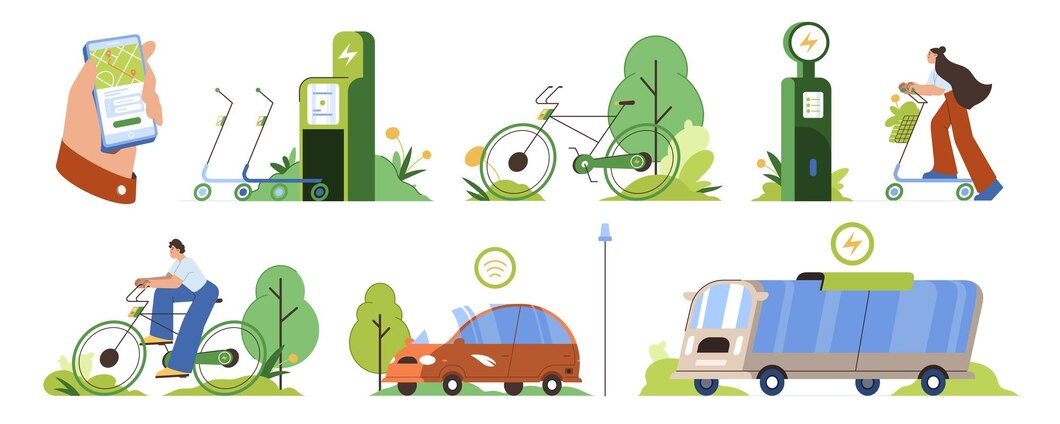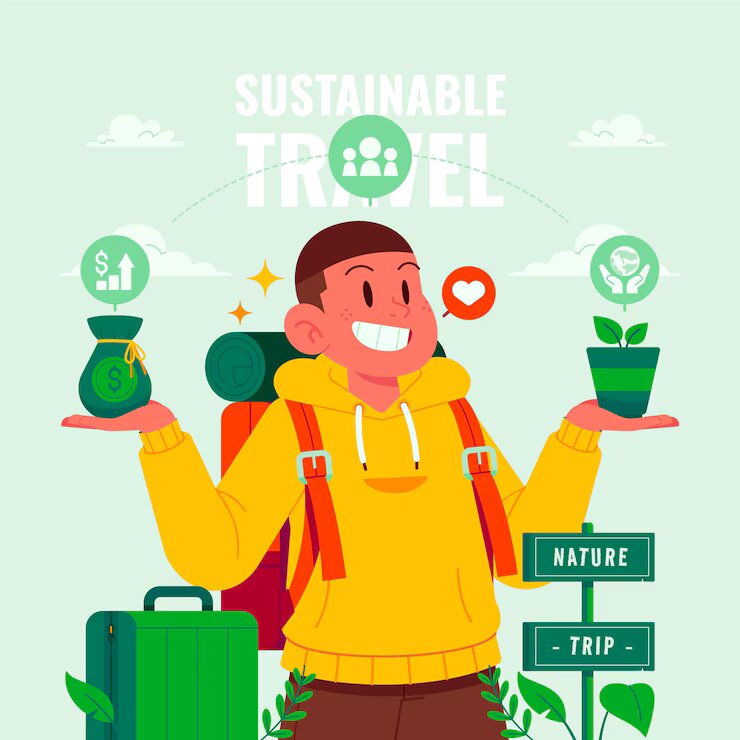Best Eco-Friendly Ways to Travel Sustainably in 2024: Expert Tips and Studies
Exploring different cultures and traditions in various safe destinations is quite common in today’s world. Travelling with family for vacation or going on a business trip can be both enjoyable and rewarding. However, the excitement of exploring new places can impact the environment, especially depending on personal transportation choices. According to the International Energy Agency, the transportation sector accounts for 19.2% of global carbon dioxide emissions, and this figure is projected to increase without decisive action.
Sustainable travel is not just about the mode of transportation; it encompasses everything from prioritising waste reduction to choosing eco-friendly accommodations and supporting local economies.
We must learn the most sustainable ways to travel, why sustainable travel matters, and how you can contribute to a future with lower CO2 emissions.

In This Article
- What Is Sustainable Travel?
- The Importance of Sustainable Travel
- Effects of Transportation on the Environment
- Climate Change and Transportation
- Eco-Friendly Ways to Travel
- Sustainable Travel Innovations and Trends
- Conclusion
What Is Sustainable Travel?
Sustainable travel is about making environmentally conscious choices to minimise damage and reduce your carbon footprint when visiting new destinations. It involves the responsible use of resources and living sustainably to protect local ecosystems.
At its core, sustainable travel means:
- Using public transportation instead of private vehicles.
- Reducing waste by not travelling with single-use plastics or using any while visiting.
- Supporting environmentally responsible businesses, from eco-friendly hostels to local artisans.
- Adopting green habits like minimising energy consumption and water use, and opting for environmentally friendly activities.
Sustainable travel fosters a deeper understanding of the local culture, promotes authentic interaction and builds appreciation for different ways of life.

The Importance of Sustainable Travel
Sustainable travel is essential to ensuring that tourism remains a positive force connecting different cultures. Over-tourism, cultural erosion, and environmental degradation threaten the peace and serenity of various tourist attractions. By practising mindful travel, we can ensure that cultural heritage is respected and iconic destinations are preserved.
Environmental Preservation
Over-tourism can harm unique ecosystems. From coral reefs to rainforests, delicate ecosystems are vulnerable to the pressures of mass tourism. Over-tourism often leads to actions like littering, which deface cultural and natural heritage sites.
For instance, Australia’s Great Barrier Reef has been threatened by climate change and tourism-related damage. The reef generates over $6.4 billion annually from tourism, yet mass tourism has led to coral bleaching and habitat destruction.
Dr Terry Hughes, a leading marine biologist from James Cook University, emphasises that “without immediate and aggressive intervention in how we manage tourism and coastal development, coral reefs like the Great Barrier Reef will continue to deteriorate, and we will lose a significant part of the Earth’s biodiversity.”
Economic Growth and Local Benefits
Sustainable travel also involves supporting local economies. Purchasing from local businesses, dining at family-owned restaurants, and staying at locally-owned accommodations help small businesses grow and create employment opportunities.
In countries like Thailand and Vietnam, sustainable tourism has bolstered small businesses within local communities. Tourists who buy from local artisans and spend money on small businesses contribute to reducing poverty in these areas. According to a study by the International Labour Organisation (ILO), for every $100 spent in a destination, approximately $70 stays in the local economy when directed toward local businesses, compared to only $20 when spent on international chains or large corporations.
Conservation of Cultural Heritage
Tourism can play an important role in preserving cultural heritage, but it also remains a major threat to it. When tourists show little or no respect for local customs, overcrowd sacred sites, or purchase mass-produced souvenirs that erode authentic culture, they endanger the heritage of these communities. Sustainable travel encourages eco-tourism by educating tourists on the importance of respecting local traditions and learning about the cultures of new destinations, rather than disrespecting them.
Reducing Over-Tourism
Over-tourism refers to the overcrowding of tourist attractions, which occurs when a destination receives more visitors than it can sustainably support. This is common in places like Machu Picchu, Bali, and Venice. Over-tourism often leads to environmental degradation, strains local infrastructure, and diminishes the quality of life for residents. Ecotourism seeks to alleviate pressure on overcrowded locations by encouraging tourists to visit lesser-known destinations.
Many tourist destinations are implementing measures to reduce overcrowding. For example, Bhutan has developed a ‘high value, low impact’ tourism policy to limit the number of visitors.
Learn More: Petrol vs. Diesel: Which Fuel is Truly Eco-Friendly?
Effects of Transportation on the Environment
Transportation remains a major contributor to carbon emissions in the travel industry. According to a report by the International Council on Clean Transportation (ICCT) in 2021, air travel alone accounts for 2.5% of carbon emissions.
Table: Environmental Impact by Mode of Transport
| Mode of Transport | CO2 Emissions (g CO2 per passenger-km) | Other Environmental Impacts |
| High water vapour emissions, noise pollution | 285 | Minimal, depends on the energy source |
| Car (gasoline) | 250 | Air pollution, land use for infrastructure |
| Train (electric) | 14 | Minimal, depends on energy source |
| Bicycle | 0 | None |
| Bus | 68 | Moderate air pollution |
| Ship (cruise) | 390 | Water pollution, invasive species spread |
Land Transportation
While air travel tends to be the main focus in discussions about transportation emissions, the contribution of gasoline and diesel vehicles is sometimes overlooked. A report by the U.S. Environmental Protection Agency (EPA) estimates that transportation is responsible for 29% of total greenhouse gas emissions, with a significant portion generated by personal vehicles.
Recommendations: Opt for electric or hybrid vehicles when possible. According to a study by the Union of Concerned Scientists, electric vehicles produce about 50% fewer emissions than gasoline-powered vehicles, even when accounting for the electricity generation process
Marine Transportation
A report by Transport and Environment suggests that the shipping industry is responsible for approximately 2 to 3% of global carbon emissions, generating about 940 million tons of CO2 annually. Large vessels also contribute to water pollution by releasing ballast water, which introduces invasive species into ecosystems, and through oil spills.
Countries are taking steps to reduce pollution caused by marine transportation. Norway, for instance, is lowering its marine carbon footprint by investing in electric ferries and exploring green hydrogen as an alternative fuel source.
Aviation and Its Impact
The aviation industry generates millions of tons of carbon dioxide. According to a report, the industry contributes significantly to global greenhouse gas emissions. The ICCT also reports that, while only a small percentage of the global population uses air travel regularly, the emissions produced are disproportionate. For instance, frequent flyers, who account for only 1% of the global population, are responsible for over half of global aviation emissions.
The aviation sector is advancing technologically, with companies like Boeing and Airbus developing next-generation aircraft that could reduce fuel consumption. Airlines like KLM and United are also investing in sustainable aviation fuels (SAFs) and carbon offset programs to mitigate their environmental footprint.
Climate Change and Transportation
Climate change is creating new challenges for the transportation industry.
Rising sea levels, changing precipitation patterns, and increased storm intensity all pose risks to transportation systems.
Sea Level Rise and Coastal Transportation
Sea levels are expected to rise, and this will continue to affect transportation infrastructure, especially in coastal cities. Ports, railways, and airports near coastal regions are likely to experience serious flooding and storm surges.
Extreme Weather and Heat
Droughts, floods, and hurricanes are extreme weather events that are occurring more frequently due to climate change. These events not only threaten the physical infrastructure of transportation systems but also their safety and reliability. For example, recurring wildfires in California have led to delayed flights, damaged railways, and road closures.
Inland regions are also affected, as heat waves can buckle rail tracks and cause road surfaces to crack. The EPA notes that transportation systems in both coastal and inland regions must adapt to climate risks to maintain resilience in the face of climate change.
Learn More: 20 Best Eco-Friendly Activities to Help Your Environment
Eco-Friendly Ways to Travel
#1. Avoid Flying When Possible
Air travel, especially long-haul flights, remains one of the largest contributors to global carbon emissions. A single flight from New York to London generates as much carbon as the average person produces in an entire year. While it may be difficult for most travellers to avoid air travel entirely, there are sustainable options worth considering.
- Opt for Direct Flights: Non-stop flights are more efficient because they avoid the extra fuel burned during take-off and landing.
- Fly Less, Stay Longer: Instead of taking several short trips, consider fewer and longer vacations to reduce your overall flight time.
- Offset Your Carbon Emissions: Many airlines now offer carbon offset programs that allow travellers to invest in environmental projects aimed at neutralising the carbon generated by flights.
Dr. Daniel Rutherford, a transportation analyst at the ICCT, points out that “while sustainable aviation fuel is a step in the right direction, it is not yet available at the scale needed to make a significant impact. Travellers must still be mindful of reducing air travel when possible.”
#2. Choose Eco-Friendly Destinations
Choosing an eco-friendly travel destination can make a difference in reducing your carbon footprint. Bhutan, Costa Rica, and Iceland are among the countries that prioritise ecotourism. In these countries, renewable energy sources, eco-lodges, and sustainable practices are the norms, ensuring that tourism benefits both the environment and local communities.
For example, Costa Rica generates over 98% of its electricity from renewable sources and offers eco-friendly lodges in rainforests and conservation tours that support wildlife protection.
Eco-Friendly Hotel Certifications
| Certification | Description | Focus Areas |
| Green Key | International eco-label for hotels, parks, and campsites. | Energy efficiency, water use, waste management |
| LEED | U.S.-based certification for sustainable buildings. | Energy savings, CO2 emissions reduction |
| EarthCheck | Global certification for sustainable tourism. | Environment, cultural heritage, community engagement |
#3. Treat Your Destination Like Home
Your vacation destination deserves to be treated with the same care as your home. Simple actions you wouldn’t overlook at home, like mindful energy and water consumption, should be prioritised at your new destination.
#4. Reduce, Reuse, and Recycle
Avoid carrying items that generate packaging waste; instead, bring reusable water bottles, straws, shopping bags, and utensils when travelling to a new destination. Many tourist destinations may lack proper waste management and recycling facilities for plastic waste, so it’s best to avoid carrying items that would generate waste while travelling.
#5. Support Local Economies
You can help keep locally-owned businesses afloat when visiting a new destination by buying from local shops, dining at local restaurants, and using local tour operators. Your support helps local economies thrive, and you’ll also have the chance to interact with locals and share your travel experiences with other tourists who are supporting these businesses.
#6. Use Electric or Hybrid Vehicles
Electric or hybrid vehicles are the future—a sustainable alternative to gasoline-powered cars. When renting a vehicle, choose an electric option if available. Electric vehicles emit 66% to 76% less carbon compared to gas-powered cars.
Norway and the Netherlands are leading nations where you can easily rent an electric vehicle for road trips. Some rental agencies now specialise in providing electric or hybrid vehicles for eco-conscious tourists.
#7. Opt for Public Transport
Public transportation systems, especially in Europe, are very accessible and efficient. If you’re visiting a destination with an efficient transportation system, consider using public buses, trains, or even renting electric bikes to get around instead of renting a gasoline-powered vehicle.
If your destination is in Europe, you should have no problem travelling within cities, as the European rail network is vast, connecting both cities and countries. According to the International Union of Railways, “rail transport is three to ten times more energy-efficient than road or air travel, depending on the country’s energy mix. Electrified trains, especially in countries like Switzerland and Sweden, offer nearly zero-emission travel options.”
Learn More: 10 Effective Ways to Adopt a Zero-Waste Lifestyle
Sustainable Travel Innovations and Trends
The future of travel looks promising as new technologies and trends emerge to make sustainable travel more accessible. Here are some of the latest innovations in sustainable travel:
Green Aviation
Airlines are adopting new technologies to make flying more sustainable. Biofuels, hydrogen-powered aircraft, and electric planes are being developed to minimise the environmental impact of air travel. Rolls-Royce and Airbus are two companies at the forefront of these advancements, aiming to reduce the aviation industry’s carbon emissions by 50% by 2050.
Regenerative Travel
This trend takes sustainable travel a step further by focusing not only on minimising harm but also on actively improving the environment. Regenerative travellers engage in activities that restore ecosystems, such as wildlife conservation projects, coral reef restoration, and tree-planting initiatives.
Slow Travel
Slow travel emphasises taking the time to fully experience unique destinations, rather than rushing through multiple locations. It reduces transportation emissions and fosters deeper connections with local cultures and environments
Eco-Luxury Travel
Eco-luxury travel caters to high-end travellers seeking comfort and exclusivity without compromising the environment. Eco-resorts in destinations such as the Maldives and Patagonia offer luxurious amenities while utilising renewable energy, sustainable building materials, and locally sourced food.”
Conclusion
Sustainable travel is about making eco-friendly choices to minimise environmental impact and reduce your carbon footprint when visiting new destinations. It involves the responsible use of resources and living sustainably to avoid harming local ecosystems.
By making eco-conscious decisions—such as choosing green destinations, using public transportation, or supporting local businesses—we can help preserve our planet’s beauty for future generations. Travelling can be enjoyable without contributing to environmental degradation.
Whether you’re exploring a bustling city or hiking through a remote forest, let your travels reflect the world you want to live in: one that respects nature, supports local cultures, and minimises its footprint. The choices we make today can help ensure that the wonders of the world endure for tomorrow.







